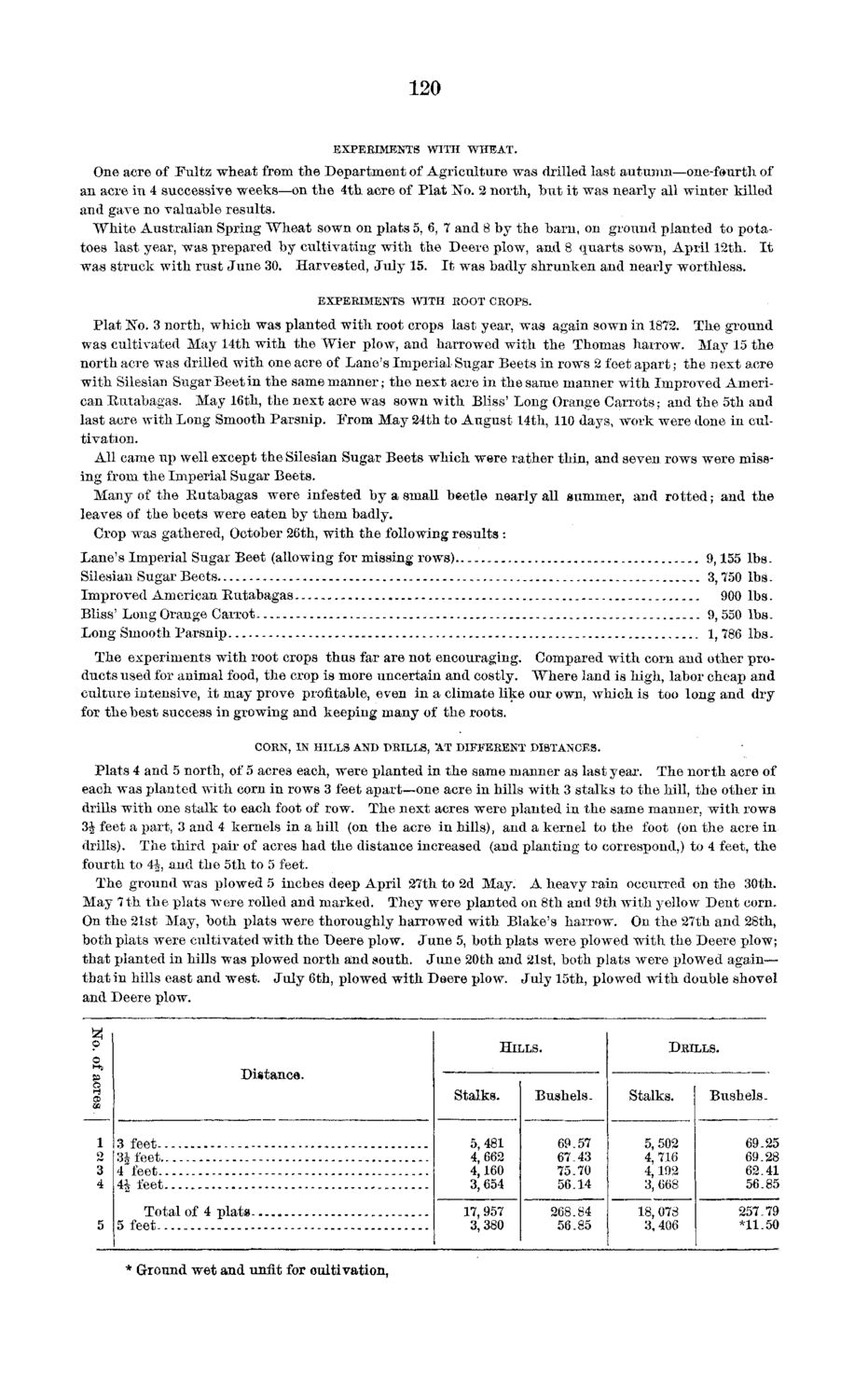| |
| |
Caption: Board of Trustees Minutes - 1873
This is a reduced-resolution page image for fast online browsing.

EXTRACTED TEXT FROM PAGE:
120 EXPERIMENTS W I T H WHEAT. One acre of Fultz wheat from the Department of Agriculture was drilled last autumn—one-fourth of an acre in 4 successive weeks—on the 4th acre of Plat No. 2 north, but it was nearly all winter killed and gave no valuable results. White Australian Spring Wheat sown on plats 5, 6, 7 and 8 by the barn, on ground planted to potatoes last year, was prepared by cultivating with the Deere plow, and 8 quarts sown, April 12th. I t was struck with rust June 30. Harvested, July 15. I t was badly shrunken and nearly worthless. EXPERIMENTS W I T H ROOT CROPS. Plat No. 3 north, which was planted with root crops last year, was again sown in 1872. The ground was cultivated May 14th with the Wier plow, and harrowed with the Thomas harrow. May 15 the north acre was drilled with one acre of Lane's Imperial Sugar Beets in rows 2 feet apart; the next acre with Silesian Sugar Beet in the same manner; the next acre in the same manner with Improved American Rutabagas. May 16th, the next acre was sown -with Bliss' Long Orange Carrots; and the 5th and last acre with Long Smooth Parsnip. From May 24th to August 14th, 110 days, work were done in cultivation. All came up well except the Silesian Sugar Beets which were rather thin, and seven rows were missing from the Imperial Sugar Beets. Many of the Rutabagas were infested by a small beetle nearly all gummer, and rotted; and the leaves of the beets were eaten by them badly. Crop was gathered, Ootober 26th, with the following results : Lane's Imperial Sugar Beet (allowing for missing rows) Silesian Sugar Beets Improved American Rutabagas Bliss' Long Orange Carrot Long Smooth Parsnip 9,155 3, 750 900 9, 550 1, 786 lbs. lbs. lbs. lbs. lbs. The experiments with root crops thus far are not encouraging. Compared with corn and other products used for animal food, the crop is more uncertain and costly. Where land is high, labor cheap and culture intensive, it may prove profitable, even in a climate like our own, which is too long and dry for the best success in growing and keeping many of the roots. CORN, IN HILLS AND DRILLS, 'AT D I F F E R E N T DISTANCES. Plats 4 and 5 north, of 5 acres each, were planted in the same manner as last year. The north acre of each was planted with corn in rows 3 feet apart—one acre in hills with 3 stalks to the hill, the other in drills with one stalk to each foot of row. The next acres were planted in the same manner, with rows 3 | feet a part, 3 and 4 kernels in a hill (on the acre in hills), and a kernel to the foot (on the acre in drills). The third pair of acres had the distance increased (and planting to correspond,) to 4 feet, the fourth to 4|, and the 5th to 5 feet. The ground was plowed 5 inches deep April 27th to 2d May. A heavy rain occurred on the 30th. May 7 th the plats were rolled and marked. They were planted on 8th and 9th with yellow Dent corn. On the 21st May, both plats were thoroughly harrowed with Blake's harrow. On the 27th and 28th, both plats were cultivated with the Deere plow. June 5, both plats were plowed with the Deere plow; that planted in hills was plowed north and south. J u n e 20th and 21st, both plats were plowed again— that in hills east and west. July 6th, plowed with Deere plow. July 15th, plowed with double shovel and Deere plow. © o Distance, HILLS. DRILLS. acres 1 o 3 4 5 3 feet 31 feet 4 feet 4 i feet - Stalks. 5,481 4,662 4,160 3,654 17, 957 3,380 Bushels. 69.57 67.43 75.70 56.14 268.84 56.85 Stalks. 5,502 4,716 4,192 3, 668 18, 078 3, 406 Bushels. 69.25 69 28 62.41 56.85 257.79 *11.50 T o t a l of 4 p l a t a * Ground wet and unfit for cultivation,
| |